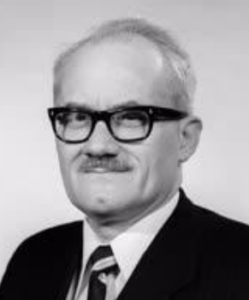György Almassy
After graduating, he became an assistant professor and university lecturer to Professor Imre Vörös at the University's Department of Mechanical Elements (1941–1946). In the meantime, he worked as a construction engineer at the Lakos and Székely company (1942).
From 1946 he was a research engineer at the then Orion Hungarian Tungsten Lamp Factory Co. Ltd. (later Orion Radio and Electricity Company ).
From 1951, he was head of the Measurement Technology Department of the Telecommunications Research Institute ( TKI ), and from 1971 until 1984, he was its head of department.
Meanwhile, he taught in different places and positions: at the Department of Power Engineering of the State Technical College, the subject of Machine Elements (1947–1951); at the Department of Aircraft, Faculty of Mechanical Engineering, Budapest University of Technology (BME), he was a lecturer in the subject of Aircraft Electrical Equipment (1948–1952); at the same time, he also taught at the Faculty of Military Engineering of BME (1950–1952); then at the Department of Wireless Communications of the Faculty of Electrical Engineering of BME, he was an assistant professor (1952–1963) and an associate professor (1963–1965). From 1965, he became a university professor at the Department of Microwave Communications of BME.
At the beginning of his scientific career, he was engaged in the theoretical and practical study of aircraft electrical equipment, then his interest turned to the theoretical foundation and development of microwave measuring instruments and methods. He developed a high-frequency cathode ray tube oscillograph, a sound-frequency symmetrical cathode ray tube oscillograph and an electronic stabilized power source. He was the developer and manager of the Hungarian microwave instrument program.
Member of the Hungarian Association of Telecommunication Engineering (HTE) (since 1949), member of the board, then secretary general (1974–1984); founding board member of the Hungarian Association of Measurement and Automation Engineering (MATE) (since 1954). Member of the Hungarian National Committee of the International Radio Science Union (Union Radio Scientifique, URSI) (since 1966); Chairman of the Hungarian National Committee of the European Organization for Quality Control (EOQC).
He was a member of the editorial board of the journals Híradástechnika and Mérés és Automátika.
His awards: Medal of Merit for Socialist Work (Hungarian government, 1955 and 1961); Kossuth Award (Hungarian state, 1962); Excellent Innovator Award, gold grade (SZOT (National Council of Trade Unions) and OTH (National Office of Inventions), 1965); Tivadar Puskás Memorial Medal (HTE, 1967); State Award (Hungarian state, 1978).
His daughter: Zsuzsa Almássy is a well-known and successful figure skater.
Created: 2024.06.06. 17:18
Last modified: 2025.02.25. 12:36

